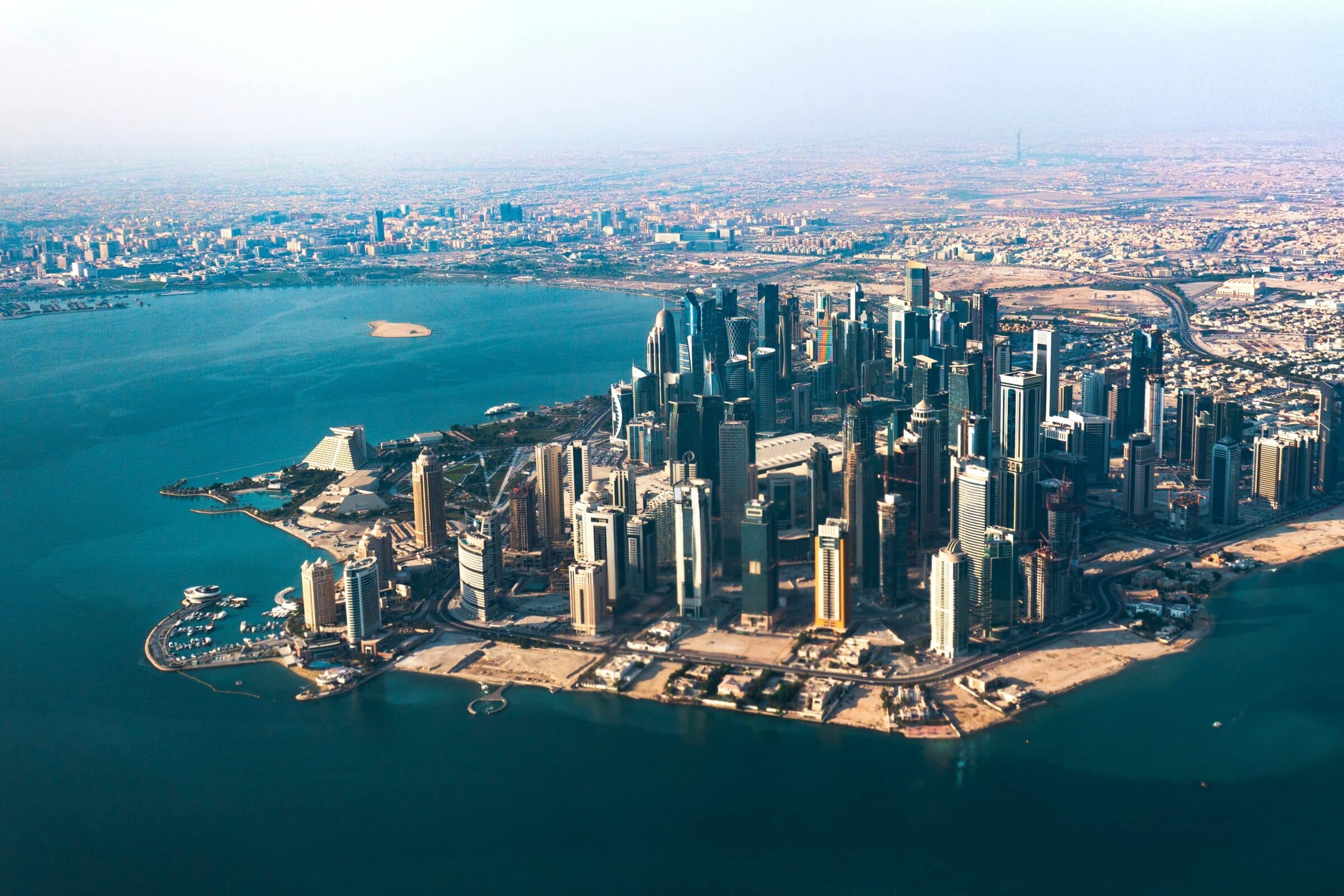Few places have taken advantage of the capabilities of the Internet of Things (IoT) like the Middle East region.
The adoption of IoT technology is already seeing a wealth of applications across a range of industries.
IoT devices and IoT SIM cards are revolutionising the way those in the region live and work, whether through seamless transport, enhanced public services, or implementing smart city agendas. One example being Saudi Arabia’s innovative and high-profile $500 billion smart city, named “The Line”.
In this article, we will explore the current IoT Middle East market, the ways the technology is being used and the various challenges the region may face going forward.
Overview of IoT in the Middle East
The Middle East is adopting IoT technology at a rapid pace, with the aim of transforming the region into a global hub for innovation and digital advancement.
Governments are endorsing and investing heavily in IoT projects, creating a conducive environment for technological expansion.
However, the adoption of IoT in the Middle East is not only impressive in its scale but also in the spectrum of its application.
From oil and gas industries leveraging IoT for predictive maintenance and resource optimisation, to smart agricultural projects that use IoT devices for precision farming and water conservation, the technology is dramatically reshaping the region’s industrial landscape.
This widespread adoption of IoT across diverse sectors is a testament to the region’s strategic vision and its determination to be at the forefront of the digital revolution.
Cities like Dubai and Abu Dhabi are incorporating IoT solutions into their urban infrastructure to improve public services and citizen living standards. For instance, Dubai’s ambitious Smart City initiative is pioneering the use of IoT for everything from traffic management to environmental monitoring.
Similarly, Saudi Arabia’s Vision 2030 plan foresees a future where IoT forms the backbone of a diversified and resilient economy. Such strategic adoption of IoT is indicative of the region’s commitment to leveraging technology to drive sustainable growth.
The IoT Middle East market
The Africa and Middle East IoT market is forecast by some for a period of unprecedented growth, with the market expected to grow from $43.99 billion USD in 2023 up to $241.65 billion USD by 2030 – which is a staggering 449% increase (CAGR 27.6%).
We can begin to see the scope of the current IoT landscape when we take a closer look at the key markets for IoT in the Middle East, including building and automation, connected logistics, banking and financial services, smart energy and utilities, and aerospace and defence.
Recent research data shows that Saudi Arabia is likely the dominant IoT enabler in this region, making up an impressive 39.63% of the region’s IoT market share, currently sitting at a total of $10.22 USD in revenue.
Other important users within the Middle East IoT sector, include the United Arab Emirates, Qatar, Kuwait and Egypt, which are collectively expected to increase at a CAGR of nearly 30% by 2028.
Ways IoT in the Middle East is being used
The Internet of Things is a technology that has been picked up and implemented in an array of different ways across multiple industries and sectors.
With a key focus on 5G and IoT across the region, these technologies are allowing for a new level of data connectivity and communication at scale – transforming the way that businesses operate.
We’ve rounded up some prime examples of how the technology is being used in Middle Eastern countries to showcase the vast potential of IoT:
“The Line” smart city project
There’s a lot to talk about when it comes to IoT and Saudi Arabia, but the most exciting project by far is their $500 billion smart city named “The Line“.
Set to be built in Neom, Tabuk Province, the 170-km-long smart city in the Saudi desert is set to revolutionise what a smart city can be.
With a key focus on transportation and infrastructure, designs for the smart city showcase how the city will run on 100% renewable energy, accommodate up to 9 million people and provide immediate access to all daily essentials.
By removing cars and roads from a city’s infrastructure and replacing them with a high-speed rail network, the city is set to be one of the most sustainable cities ever built.
However, this project would not be possible without recent advancements in IoT.
“The Line” leverages the power of IoT sensors to create an optimal, comfortable living environment amidst the harsh desert climate.
These sensors will be integrated into the city’s infrastructure and constantly monitor the temperature, humidity, and other environmental factors. Based on real-time data, the city’s HVAC systems will adjust accordingly to maintain an ideal indoor environment.
These IoT sensors are also set to play a crucial role in energy conservation. Triggering energy-saving modes for systems during less demanding periods, optimising power use and enabling the city to sustainably achieve its 100% renewable energy goal.
Other implementations of this software include the optimisation of renewable energy sources, the maintenance of constant connectivity on the high-speed rail network, and the automation of daily services and basic needs.
These advancements in the use of IoT technology will showcase how IoT can not only transform urban living but also set a benchmark and stage for how future smart cities may be conceived and implemented.
Advancements in the automotive sector
Another interesting use case of IoT in the Middle East is some of the United Arab Emirates’s (UAE) automotive projects.
Such projects have played a pivotal part in Dubai’s ambitions to be the world’s first ‘true’ smart city, with one key example being Dubai’s Smart Pedestrian Signals project.
Orchestrated by Dubai’s Roads and Transport Authority (RTA), the project aims to provide seamless traffic management around the smart city that provides optimal safety for both pedestrians and motorists.
The Smart Pedestrian Signal technology is operated by a network of IoT sensors connected to a ground optical system synchronised within the signal light’s operation.
It works by activating a red light when a pedestrian approaches the signal, allowing them to cross the road. The system senses when no one is crossing and automatically returns to green, streamlining traffic management.
This is an interesting example of smart infrastructure utilising IoT technologies when seeking to balance energy efficiency, usability, and safety. It also showcases the UAE’s commitment to achieving its goals of ‘Smart Dubai’ by challenging norms in its aim of becoming the world’s smartest city.
Abu Dhabi also has IoT automotive ambitions. For example, an implementation of self-driving taxis rolling out around the city currently has over 5,000 registered users (www.iotworldtoday.com, 2023).
The taxis use IoT technology to navigate through the city’s streets. Each self-driving taxi is equipped with an array of IoT devices that continuously gather data about the surrounding environment.
This data is processed in real-time to create a 3D map of the vehicle’s surroundings, enabling it to identify obstacles, road signs, and other vehicles, and make decisions on how to navigate.
The taxis are also connected to a city-wide IoT network that provides real-time traffic updates, weather conditions, and roadwork information, enabling the vehicle to adapt its route in response to any changes in the traffic environment.
Furthermore, the IoT technology within these taxis allows for predictive maintenance. Various sensors monitor the health of the vehicle’s components and alert the control centre when a part is wearing out or malfunctioning. This proactive approach reduces downtime and improves the overall efficiency of the service.
While self-driving vehicles are a much-deliberated concept and vision, such projects are testing the performance and boundaries of such technologies. Showcasing how IoT solutions rely on collaboration and test cases to engineer progress.
Gulf public cloud data services
Another exciting IoT infrastructure development that highlights the importance of collaboration is in Bahrain. Amazon Web Services (AWS) opened a cloud data centre in 2019 – its first in the Middle East.
The launch of this cloud service provides those within the Bahraini zone with an advanced, secure, and jurisdictional infrastructure to store and manage data.
This is a big step forward in the development of IoT technology within the region, as it provides a safe platform for businesses to build applications securely with lower concerns of non-compliance, data interception or theft.
Most businesses use cloud services for their data storage needs, opening a realm of possibilities for IoT applications that use cloud-based analytics and Machine Learning (ML).
This AWS cloud data centre, in conjunction with AWS’s Edge network in Dubai and Fujairah, provides businesses with an ideal platform to develop and deploy IoT applications at scale. This also allows companies in the Middle East to develop and deploy projects faster, cheaper, more efficiently and with less latency than before.
The launch of AWS’s cloud region is just one example of how the adoption of technology can help accelerate economic growth within a region. Companies can leverage more analytics provided by IoT devices and as a result, gain valuable insights into their operations.
Processes can become more efficient; costs can be reduced and with innovation, new business models can be created to drive growth.
Key agricultural developments
The last of our key talking points investigates the opportunity for smart farming through connected machines and IoT sensors.
Agriculture is a key employer in areas such as Sudan (38% of all jobs) and Yemen (28% of all jobs), despite being in the Mobile Economy Middle East and North Africa (MENA) region – the most water-stressed region in the world where agriculture uses 85% of the region’s water.
Additionally, in two-thirds of the countries in the MENA, less than 5% of the land is arable. This creates unique challenges and tensions for food production.
In areas where agricultural practices occur, IoT technology is used to optimise yields, improve irrigation systems, and precisely monitor soil health within this highly challenging environment.
Using sensor and data collection technology, producers can optimise water consumption and direct water delivery to those sections that need it the most. Thus, mitigating the obvious effects on the region’s severe water stress.
Precision agricultural systems, powered by IoT devices, aid in crop health monitoring and early disease detection. Important for a highly sensitive yield. This is another example of IoT-based environmental monitoring that is seeking to develop more understandable and proactive systems for increasing quality of life and produce.
Through data digestion, processing and analysis, this ecosystem can be optimised to promote a healthier and more sustainable yield of crops.
Other areas, such as Lebanon, are implementing Ground Vertical Farming which can increase planting space by 256% and save water use by up to 90% each day by recirculating water and nutrients.
This intelligent farming technology is again made possible by IoT sensors that monitor all aspects of crop health, including soil temperature, PH level and nutrient levels, allowing farmers to make informed decisions on where and when to irrigate.
IoT Middle East challenges
The implementation of IoT technology has great potential to create economic growth and greater economic diversity for countries within the Middle East region. This is not to say, however, that the region doesn’t face some unique IoT challenges in its adoption of the technology.
Some of the key issues are:
1) Upfront Cost of implementation
The investment cost required to implement both large scale and smaller enterprise initiatives that need to implement IoT technology can be a significant barrier, in some areas more than others.
For example, the investment costs associated with purchasing and installing IoT devices can be prohibitive for smaller or less established companies.
Acquisition of hardware and software, as well as establishing a secure and reliable supporting infrastructure can be a barrier.
Besides the initial setup cost, there are ongoing operational expenses, including maintenance, system upgrades, and cybersecurity measures. Particularly in regions where the economy is still developing, these costs may hinder the widespread adoption of IoT technology.
A viable solution to this issue can be the formation of public-private partnerships, where governments and private companies collaborate to share the costs of IoT implementation and adoption. Of course, these initiatives usually require some wider economic, technological, or social benefit.
Adopting a phased and organic approach towards IoT deployment, starting with pilot projects before scaling up, can help to manage risks and help evaluate the adoption, revenues, and costs and therefore the return on investment in manageable stages.
2) Insufficient Resources
Another common IoT challenge is a lack of skilled personnel and robust infrastructure which can pose a significant hurdle to the wider adoption of IoT.
The successful implementation and management of IoT technology will require a workforce with specialised knowledge in areas such as data analysis, cybersecurity, and network management.
Gaps in certain areas make IoT implementation challenging but highlight the importance of partnerships and collaboration.
Relevant technical skills need to form part of educational initiatives and systems and companies need to train emerging staff in the technical and logistical peculiarities of the industry.
The creation of a solid digital infrastructure that can reliably and securely support IoT networks is pivotal. This can be achieved through government-led initiatives, incentives, or through collaboration, which can require a change in business thinking.
3) Data privacy, security, and governance
As with any IoT operation, data privacy, security and governance emerge as key challenges.
The sheer volume and sensitivity of data generated by some IoT use cases raise serious concerns about data privacy and security, meaning that preventive measures must be implemented to protect individual data rights, company data, data jurisdiction law and any sensitive information transmitted or stored.
With the increased need for connectivity which is a fundamental part of IoT systems, there are higher risks of data breaches and cyber-attacks, which could compromise sensitive user information and undermine the reliability of IoT networks.
Adopting comprehensive data protection measures and policies, including high-level encryption and secure access controls, along with implementing well-defined data governance policies provides protection. It is also important, however, to consider the need to anonymise data wherever possible, to ensure that even if a breach occurs, it lacks any utility, and its impact is none or negligible on the individual or the originating location.
Additionally, governments must ensure that the appropriate legal and regulatory frameworks are in place to protect data from potential misuse or exploitation. This requires an effective system of rules, processes and procedures that allow organisations to safely collect, store and analyse data and the purposes for which they are accepted.
Establishing clear guidelines for data ownership, anonymisation, usage, and sharing can help mitigate data risks and any concerns that might restrict IoT adoption. Additionally, collaboration with international bodies to align with global data protection standards can also enhance trust in the region’s IoT ecosystem. IoT ecosystems are reliant on API’s. They allow disparate systems to communicate within set and secure parameters that enable data exchange without compromising either system, the individual or the data integrity.
4) Connectivity Challenges
Connectivity challenges in the Middle East region are both at a country and local level.
Most IoT systems rely on multi-network SIM cards which enable resilient connectivity to a range of locally available networks. These typically use offshore roaming systems that are designed and optimised for IoT devices. Some countries such as Saudi Arabia and UAE, Turkey, Brazil, China & India, however, effectively restrict or ban such permanent roaming systems. That is devices cannot remain on the local networks for a long period of time (typically over 90 days). This can be overcome using an eUICC IoT SIM Card which can be changed to a local network IMSI if required. This, also, enables the affordability of local networks to be utilised.
For this reason, it is important to place connectivity at the heart of the system or solution design. Too many companies think that this can be left to the end of the process, assuming that connectivity is a commodity. To ensure that the devices work effectively on mobile networks and that they are future, and region-proofed with the right supporting systems, cost structures and infrastructure, it is imperative that they form part of the design and planning phases.
Connectivity issues in rural areas can also present a formidable challenge for the expansion of IoT where no mast is in range.
Given the region’s vast desert landscapes with remote and sparsely populated areas, establishing reliable internet connectivity in these areas can be problematic, curtailing the reach of IoT applications.
Without consistent access to core data/internet networks, IoT devices are unable to communicate effectively, significantly hindering their utility and benefits.
One solution is low-power, wide-area (LPWA) networks such as LTE-M and NB-IoT. These networks offer a longer range from masts and have low power mode support, which helps conserve device batteries and power budgets, making them ideal for very remote applications.
Investment in 5G networks across the region will obviously help bolster internet connectivity and facilitate the growth of IoT across urban areas.
Global IoT connectivity solutions
In conclusion, while the Middle East faces certain challenges in adopting the Internet of Things (IoT), the potential for growth is exciting.
With strategic investments in infrastructure, skill development, comprehensive data measures and global partnerships, entities within the Middle East region can overcome these obstacles and fully exploit the transformative potential of IoT.
By prioritising IoT, the region can continue to drive forward its digital economy and continue to be seen as an innovator and leading adopter of IoT, and in so doing, help enable businesses to innovate and grow.
At Caburn Telecom, we provide best-in-class Global IoT Connectivity solutions, and we’re excited to support this journey towards a more connected future.
Being an industry leader in global IoT connectivity solutions, Caburn Telecom offers secure, cost-effective, and reliable multi-network roaming services wherever you need to deploy.
Please contact a member of our team today to unlock your business’s global potential and benefit from a truly connected world of IoT.



